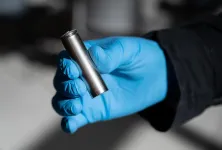(Press-News.org) A new study of the U.K. and South Africa variants of SARS-CoV-2 predicts that current vaccines and certain monoclonal antibodies may be less effective at neutralizing these variants and that the new variants raise the specter that reinfections could be more likely.
The study was published in Nature on March 8, 2021. A preprint of the study was first posted to BioRxiv on January 26, 2021.
David Ho (Credit: Columbia University Irving Medical Center)
The study's predictions are now being borne out with the first reported results of the Novavax vaccine, says the study's lead author David Ho, MD. The company reported on Jan. 28 that the vaccine was nearly 90% effective in the company's U.K. trial, but only 49.4% effective in its South Africa trial, where most cases of COVID-19 are caused by the B.1.351 variant.
"Our study and the new clinical trial data show that the virus is traveling in a direction that is causing it to escape from our current vaccines and therapies that are directed against the viral spike," says Ho, the director of the Aaron Diamond AIDS Research Center and the Clyde'56 and Helen Wu Professor of Medicine at Columbia University Vagelos College of Physicians and Surgeons.
"If the rampant spread of the virus continues and more critical mutations accumulate, then we may be condemned to chasing after the evolving SARS-CoV-2 continually, as we have long done for influenza virus," Ho says. "Such considerations require that we stop virus transmission as quickly as is feasible, by redoubling our mitigation measures and by expediting vaccine rollout."
After vaccination, the immune system responds and makes antibodies that can neutralize the virus.
Ho and his team found that antibodies in blood samples taken from people inoculated with the Moderna or Pfizer vaccine were less effective at neutralizing the two variants, B.1.1.7, which emerged last September in England, and B.1.351, which emerged from South Africa in late 2020. Against the U.K. variant, neutralization dropped by roughly 2-fold, but against the South Africa variant, neutralization dropped by 6.5- to 8.5-fold.
"The approximately 2-fold loss of neutralizing activity against the U.K. variant is unlikely to have an adverse impact due to the large 'cushion' of residual neutralizing antibody activity," Ho says, "and we see that reflected in the Novavax results where the vaccine was 85.6% effective against the U.K. variant."
Data from Ho's study about the loss in neutralizing activity against the South Africa variant are more worrisome.
"The drop in neutralizing activity against the South Africa variant is appreciable, and we're now seeing, based on the Novavax results, that this is causing a reduction in protective efficacy," Ho says.
The new study did not examine the more recent variant found in Brazil (B.1.1.28) but given the similar spike mutations between the Brazil and South Africa variants, Ho says the Brazil variant should behave similarly to the South Africa variant.
"We have to stop the virus from replicating and that means rolling out vaccine faster and sticking to our mitigation measures like masking and physical distancing. Stopping the spread of the virus will stop the development of further mutations," Ho says.
The study also found that certain monoclonal antibodies used now to treat COVID patients may not work against the South Africa variant. And based on results with plasma from COVID patients who were infected earlier in the pandemic, the B.1.351 variant from South Africa has the potential to cause reinfection.
New study contains comprehensive analysis of variants
The new study conducted an extensive analysis of mutations in the two SARS-CoV-2 variants compared to other recent studies, which have reported similar findings.
The new study examined all mutations in the spike protein of the two variants. (Vaccines and monoclonal antibody treatments work by recognizing the SARS-CoV-2 spike protein.)
The researchers created SARS-CoV-2 pseudoviruses (viruses that produce the coronavirus spike protein but cannot cause infection) with the eight mutations found in the U.K. variant and the nine mutations found in the South African variant.
They then measured the sensitivity of these pseudoviruses to monoclonal antibodies developed to treat COVID patients, convalescent serum from patients who were infected earlier in the pandemic, and serum from patients who have been vaccinated with the Moderna or Pfizer vaccine.
Implications for monoclonal antibody treatments
The study measured the neutralizing activity of 18 different monoclonal antibodies--including the antibodies in two products authorized for use in the United States.
Against the U.K. variant, most antibodies were still potent, although the neutralizing activity of two antibodies in development was modestly impaired.
Against the South Africa variant, however, the neutralizing activity of four antibodies was completely or markedly abolished. Those antibodies include bamlanivimab (LY-CoV555, approved for use in the United States) that was completely inactive against the South Africa variant, and casirivimab, one of the two antibodies in an approved antibody cocktail (REGN-COV) that was 58-fold less effective at neutralizing the South Africa variant compared to the original virus. The second antibody in the cocktail, imdevimab, retained its neutralizing ability, as did the complete cocktail.
"Decisions of the use of these treatments will depend heavily on the local prevalence of the South Africa and Brazil variants," Ho says, "highlighting the importance of viral genomic surveillance and proactive development of next-generation antibody therapeutics."
Reinfection implications
Serum from most patients who had recovered from COVID earlier in the pandemic had 11-fold less neutralizing activity against the South Africa variant and 4-fold less neutralizing activity against the U.K. variant.
"The concern here is that reinfection might be more likely if one is confronted with these variants, particularly the South Africa one," Ho says.
INFORMATION:
Hamilton, ON (March 8, 2021) - An analysis of several large studies involving participants from more than 60 countries, spearheaded by researchers from McMaster University, has found that eating oily fish regularly can help prevent cardiovascular disease (CVD) in high-risk individuals, such as those who already have heart disease or stroke.
The critical ingredient is omega-3 fatty acids, which researchers found was associated with a lower risk of major CVD events such as heart attacks and strokes by about a sixth in high-risk people who ate two servings of fish rich in omega-3 each week.
"There is a significant protective benefit of fish consumption in people with cardiovascular disease," said lead co-author Andrew Mente, associate ...
Personalised 3D printed models created from cardiac imaging data, mainly from cardiac CT images have been increasingly used in cardiovascular disease, primarily in the preoperative planning and simulation of complex surgical procedures, as well as medical education. 3D printed models are proved to be highly accurate in replicating normal anatomy and cardiac pathology with reported differences less than 0.5 mm between 3D printed models and original sources images. Further to these applications, a new research direction of utilising 3D printed models is to study the optimal CT scanning protocols in cardiovascular disease with the aim of reducing radiation dose while preserving diagnostic image quality. To achieve ...
A new fabrication technique could allow solid-state automotive lithium-ion batteries to adopt nonflammable ceramic electrolytes using the same production processes as in batteries made with conventional liquid electrolytes.
The melt-infiltration technology developed by materials science researchers at the Georgia Institute of Technology uses electrolyte materials that can be infiltrated into porous yet densely packed, thermally stable electrodes.
The one-step process produces high-density composites based on pressure-less, capillary-driven infiltration of a molten solid electrolyte into porous bodies, including multilayered electrode-separator stacks.
"While the melting point of traditional ...
You've heard of animals that can lose and then regenerate a tail or limb. But scientists reporting in the journal Current Biology on March 8 have now discovered two species of sacoglossan sea slug that can do even better, shedding and then regenerating a whole new body complete with the heart and other internal organs. The researchers also suggest that the slugs may use the photosynthetic ability of chloroplasts they incorporate from the algae in their diet to survive long enough for regeneration.
"We were surprised to see the head moving just after autotomy," said Sayaka Mitoh of Nara ...
It's no secret that the United States' $13 billion cannabis industry is big business. Less obvious to many is the environmental toll this booming business is taking, in the form of greenhouse gas emissions from commercial, mostly indoor production.
A new study by Colorado State University researchers provides the most detailed accounting to date of the industry's carbon footprint, a sum around which there is only limited understanding. What is clear, though, is that consumer demand for cannabis is insatiable and shows no signs of stopping as more states sign on to legalization.
The study, ...
The economic benefits of conserving or restoring natural sites "outweigh" the profit potential of converting them for intensive human use, according to the largest-ever study comparing the value of protecting nature at particular locations with that of exploiting it.
A research team led by the University of Cambridge and the Royal Society for the Protection of Birds (RSPB) analysed dozens of sites - from Kenya to Fiji and China to the UK - across six continents. A previous breakthrough study in 2002 only had information for five sites.
The findings, published in the journal Nature Sustainability, come just weeks after a landmark report by Cambridge Professor Partha Dasgupta called for the value of biodiversity to be placed at the heart of global economics.
For the latest ...
Coastal populations are experiencing relative sea-level rise up to four times faster than the global average - according to new research from the University of East Anglia.
A new study published today in Nature Climate Change is the first to analyse global sea-level rise combined with measurements of sinking land.
The impact of subsidence combined with sea-level rise has until now been considered a local issue rather than a global one.
But the new study shows that coastal inhabitants are living with an average sea level rise of 7.8 mm - 9.9 mm per year over the past twenty years, compared with a global average rise of 2.6mm a year.
And the impacts are far larger than the global numbers reported ...
LA JOLLA--(March 8, 2021) Deep learning is a potential tool for scientists to glean more detail from low-resolution images in microscopy, but it's often difficult to gather enough baseline data to train computers in the process. Now, a new method developed by scientists at the Salk Institute could make the technology more accessible--by taking high-resolution images, and artificially degrading them.
The new tool, which the researchers call a "crappifier," could make it significantly easier for scientists to get detailed images of cells or cellular structures that have previously been difficult to observe because they require low-light conditions, such as mitochondria, which can ...
What The Study Did: Researchers assessed the number of hospital admissions for noncommunicable diseases (abnormal tissue growths, metabolic diseases, cardiovascular diseases and musculoskeletal diseases) in São Paulo, Brazil, between January and June last year compared with the corresponding periods in the previous three years.
Authors: Fernando Adami, Ph.D., of the Laboratório de Epidemiologia e Análise de Dados, Centro Universitário Saúde ABC in São Paulo, Brazil, is the corresponding author.
To access the embargoed study: Visit our For The Media website at this link https://media.jamanetwork.com/
(doi:10.1001/jamanetworkopen.2021.0799)
Editor's Note: Please ...
Menlo Park, Calif. -- Scientists have taken a major step forward in harnessing machine learning to accelerate the design for better batteries: Instead of using it just to speed up scientific analysis by looking for patterns in data, as researchers generally do, they combined it with knowledge gained from experiments and equations guided by physics to discover and explain a process that shortens the lifetimes of fast-charging lithium-ion batteries.
It was the first time this approach, known as "scientific machine learning," has been applied to battery cycling, said Will Chueh, an associate ...

